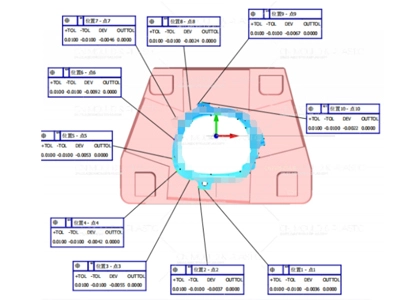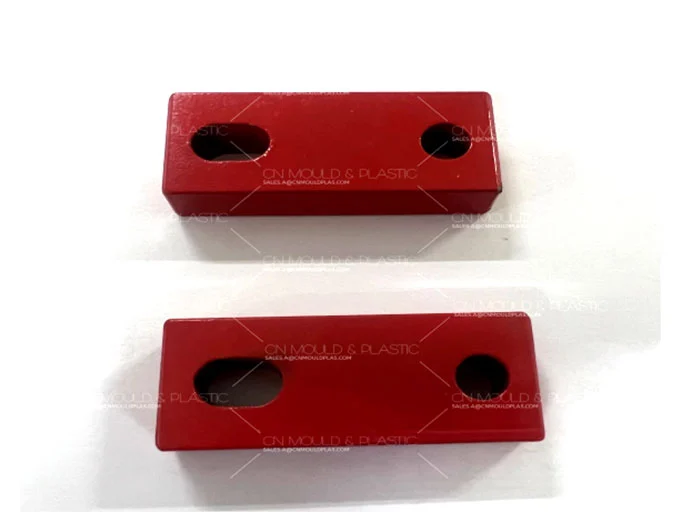(1) Plastic parts need a draft angle. When the mold opens, we need the plastic part to come out smoothly from the cavity and core. Without a draft angle, the part might stick to the mold, or get messed up during demolding – like surface scratches, pulls, dents, white marks, or even warping. For both the inner and outer surfaces of the part, we take the mold's parting line as the boundary. The outer surfaces along the mold-opening direction must have a reasonable and enough draft angle, usually 3° to 5°. Check out Figure 1-1 (b) for an example.

(2) The demolding slopes on the inner and outer sides of the plastic part are different. When the inner and outer sides of the plastic part in the same direction are molded by the moving mold and the fixed mold, the demolding slope of the concave mold should be larger than that of the convex mold, as shown in Figure 1-2. The purpose of this is to make the plastic part stay on the moving mold side, that is, the demolding slope of the inner side of the plastic part should be smaller than that of the outer side to facilitate demolding.

(3) Choosing the demolding slope based on the plastic part's geometry the geometric shape of the plastic part also affects the demolding slope. For parts with complex shapes, greater height, deeper holes, or more molded holes, a larger demolding slope is needed. Parts with thicker walls can also use a larger slope. But note: for products with higher precision requirements, avoid excessive demolding slopes. To ensure precision, it's better to use a smaller slope.
(4) No inverted taper in plastic parts Designers should avoid undercuts in the part's outer shape. If the inner or outer shape has an inverted taper, it will make demolding difficult.
(5) Proper selection of demolding slope different plastics require different demolding slopes. The slope should be chosen based on the plastic type and its rigidity. Hard plastics and those with high shrinkage rates need larger slopes, and reinforced plastic products are better with a larger slope, typically 1° to 1°30’. Table 1-1 shows demolding slopes for several plastics.
Table 1-1 Demolding slopes for several plastics.
Plastic Names | Draft Angle | Draft Angle β |
Cavity α | Core β | |
Polyethylene (PE), Polypropylene (PP), Soft Polyvinyl Chloride | 45′~1° | 30′~45′ |
ABS, Polyamide (PA), Polyoxymethylene (POM), Chlorinated Polyether, Polycarbonate | 1°~1°30′ | 40′~1° |
Hard Polyvinyl Chloride, Polystyrene (PS), Polyethylene Terephthalate (PET), Polymethyl Methacrylate (PMMA), Polycarbonate (PC), Polysulfone | 1°~2° | 50′~1°30′ |
Thermosetting Plastics | 40′~1° | 20′~50′ |
(6) Key Factors for Draft Angle Selection
1.Shape and Wall Thickness of Plastic Parts: The draft angle chosen depends on the part’s shape and wall thickness—thicker walls exert greater clamping force, influencing the angle needed.
2.Dimensional Accuracy Requirements: When high precision is critical, the draft angle can’t be too large. Instead, select an appropriate angle within the allowable range to balance release and precision.
3.Plastic Material Properties and Shrinkage Rate: The draft angle should align with the material’s characteristics. For example, ABS has a stronger clamping force than PP, so it requires a larger draft angle for easy release.
(7) Draft Angles for Textured Side Surfaces
The draft angle for parts with textured surfaces (like leather grain or cloth patterns) is directly related to the texture depth. If the draft angle is insufficient for textured outer sides, the surface may pull, fray, or turn white. Here’s a breakdown of draft angles for different surface finishes:
• Matte surfaces: Draft angle α ≥ 2°
• Leather grain/cloth patterns: Draft angle α = 3°–5°
• Text/embossed patterns: Draft angle α = 8°–10°
• Text/symbols (high-release needs): Draft angle α > 10°. For concave pits with raised text, the pit should be 0.2mm deeper than the raised text.
• Raised height: At least 0.2mm (typically 0.4–0.8mm)
• Line width: Minimum 0.3mm
• As a rule, the height of text/symbol lines shouldn’t exceed their width to maintain structural strength.
For etched surfaces, the mold cavity is sandblasted or etched. The draft angle should be:
• ≥ 3° if surface roughness (Ra) < 6.3μm
• ≥ 4° if Ra > 6.3μm
Refer to Table 1-2 for recommended draft angles by plastic material and the specific angles needed based on texture coarseness.
Table 1-2 Comparison of Texture Depth on the Side of Plastic Parts and Draft Angle
Number | Texture Depth / in | Minimum Draft Angle / (°) | Number | Texture Depth / in | Minimum Draft Angle / (°) |
MT-11000 | 0.0004 | 1.5 | MT-11200 | 0.003 | 4.5 |
MT-11010 | 0.001 | 2.5 | MT-11205 | 0.0025 | 4 |
MT-11020 | 0.0015 | 3 | MT-11210 | 0.0035 | 5.5 |
MT-11030 | 0.002 | 4 | MT-11215 | 0.0045 | 6.5 |
MT-11040 | 0.003 | 5 | MT-11220 | 0.005 | 7.5 |
MT-11050 | 0.0045 | 6.5 | MT-11225 | 0.0045 | 6.5 |
MT-11060 | 0.003 | 5.5 | MT-11230 | 0.0025 | 4 |
MT-11070 | 0.003 | 5.5 | MT-11235 | 0.004 | 6 |
MT-11080 | 0.002 | 4 | MT-11240 | 0.0015 | 2.5 |
MT-11090 | 0.0035 | 5.5 | MT-11245 | 0.002 | 3 |
MT-11100 | 0.006 | 9 | MT-11250 | 0.0025 | 4 |
MT-11110 | 0.0025 | 4.5 | MT-11255 | 0.002 | 4 |
MT-11120 | 0.002 | 4 | MT-11260 | 0.004 | 3 |
MT-11130 | 0.0025 | 4.5 | MT-11265 | 0.005 | 6 |
MT-11140 | 0.0025 | 4.5 | MT-11270 | 0.004 | 7 |
MT-11150 | 0.00275 | 5 | MT-11275 | 0.0035 | 6 |
MT-11160 | 0.004 | 6.5 | MT-11280 | 0.0055 | 8 |
Notes:
1. 1 in = 25.4 mm.
2. The draft angles in the table are determined based on ABS plastic. In actual application, adjustments should be made according to molding conditions, molding materials, and changes in wall thickness.

